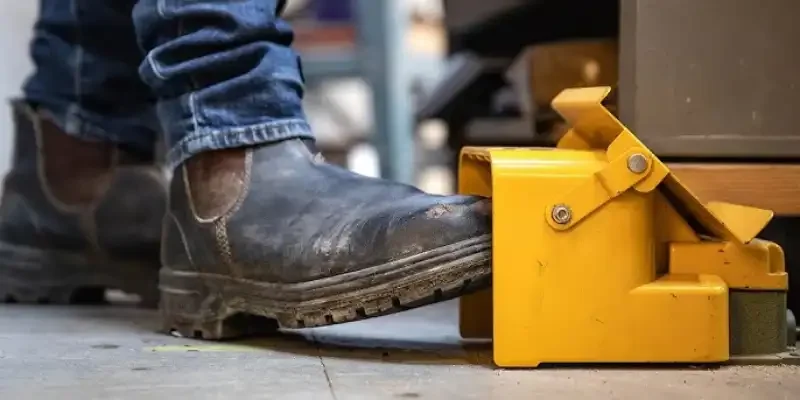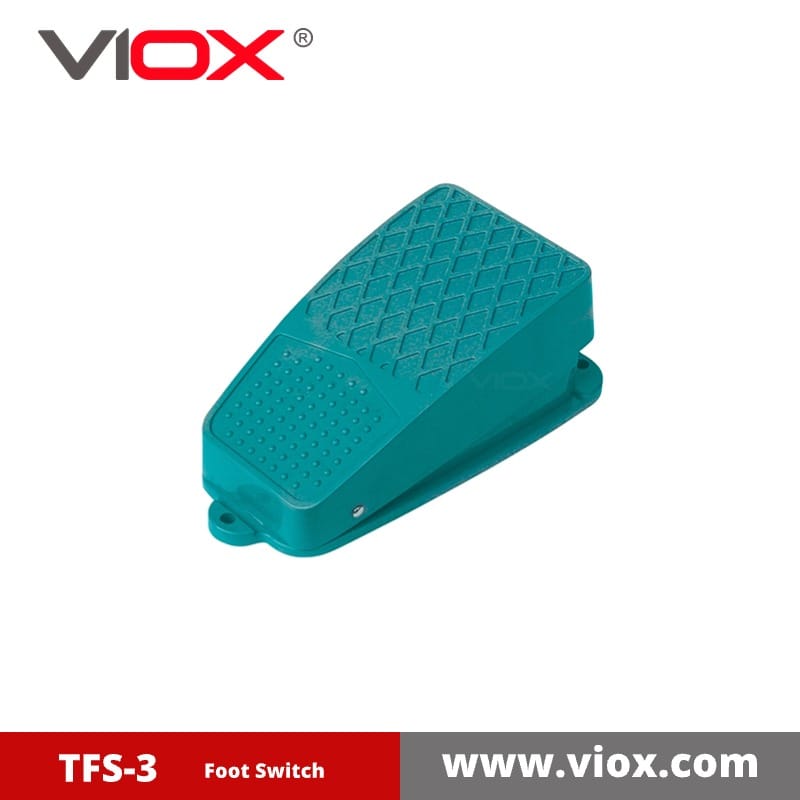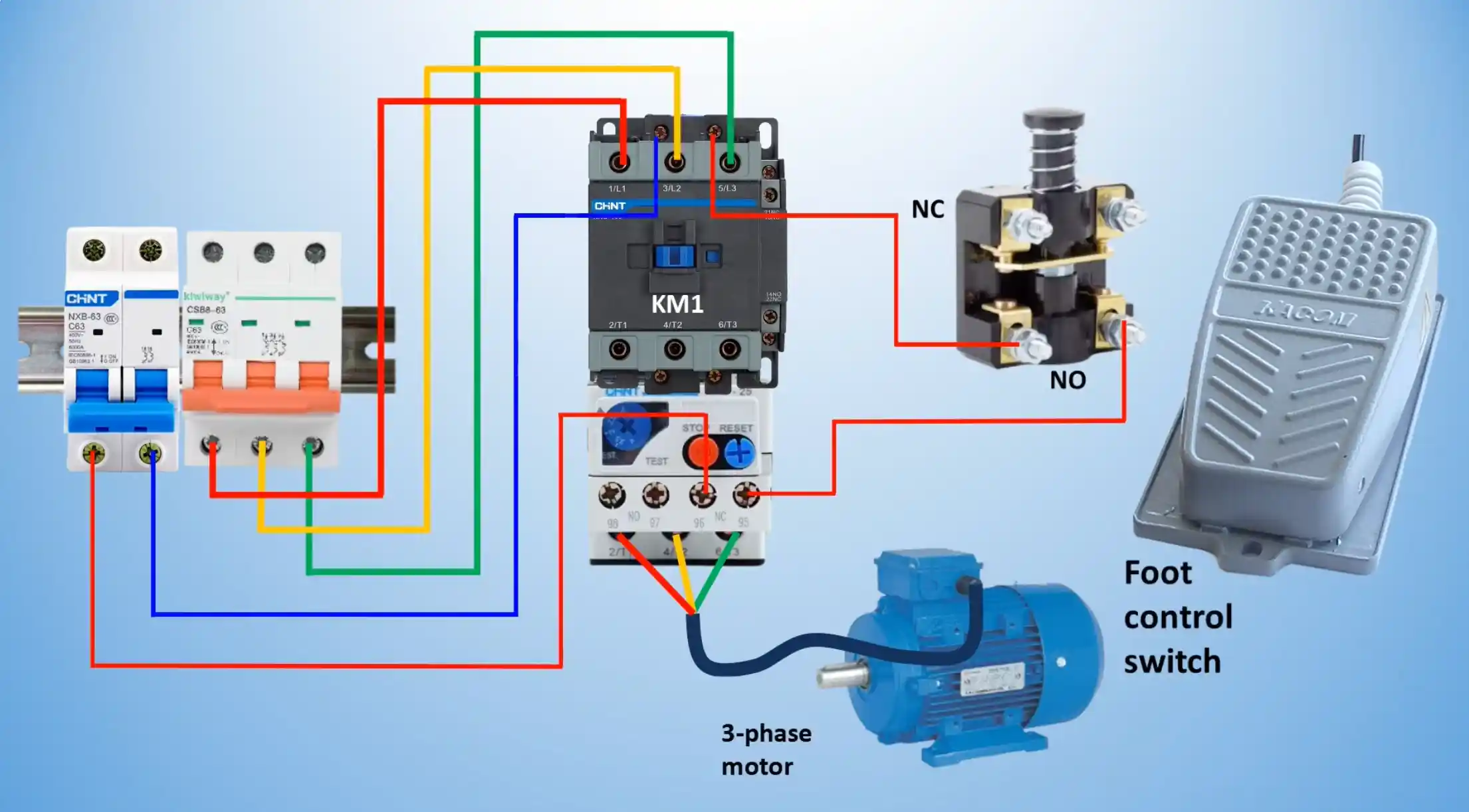Що таке педальний перемикач
Педальні вимикачі, часто відомі як ножні вимикачі або ножні педалі, - це пристрої, що керуються тиском ноги для керування електричними ланцюгами або механічними системами. Функція "вільні руки" дозволяє користувачам керувати обладнанням без використання рук, що підвищує продуктивність і зручність у різних сферах застосування.
II. Типи ножних перемикачів
A. Однопедальні вимикачі
Найпростіший тип ножні педалі це однопедальні перемикачі, які мають одну педаль, що регулює одну функцію. Вони часто використовуються в таких пристроях, як швейні машини та медичне обладнання, які потребують простого увімкнення/вимкнення. Залежно від потреб операції, ці перемикачі можуть бути налаштовані як фіксуючі або миттєві.
B. Багатопедальні вимикачі
Багатопедальні перемикачі складаються з двох або більше педалей, що дозволяє керувати кількома функціями одночасно або незалежно
C. Миттєві та фіксуючі педальні вимикачі
Ножні вимикачі можна класифікувати за типом дії:
- Миттєві педальні вимикачі: Вони потребують постійного натискання, щоб залишатися увімкненими. Перемикач повертається до початкового положення, коли лапка піднімається. Цей тип часто використовується в таких пристроях, як швейні машини та медичне обладнання, які потребують миттєвої активації.
- Фіксація ножних вимикачівЯк і вимикач, вони вмикаються після натискання і вимикаються лише після повторного натискання. Ця функція стає в нагоді, коли необхідно продовжити роботу без натискання, що є дуже зручним.
D. Електронні та механічні педальні перемикачі
Ножні вимикачі також можна класифікувати на основі їхніх внутрішніх механізмів:
- Механічні ножні перемикачі: Вони відомі своєю витривалістю та тактильним відгуком і використовують фізичні зв'язки. Вони ідеально підходять для використання там, де потрібна міцна і надійна робота, наприклад, у музичних інструментах або великих механізмах.
- Електронні педальні перемикачі: Вони використовують електричні з'єднання для активації і можуть запропонувати більш чутливі та різноманітні функції, ніж механічні перемикачі. Вони підходять для складних застосувань, оскільки можуть мати такі функції, як різні варіанти схем і програмовані налаштування.
Внутрішня будова ножного перемикача
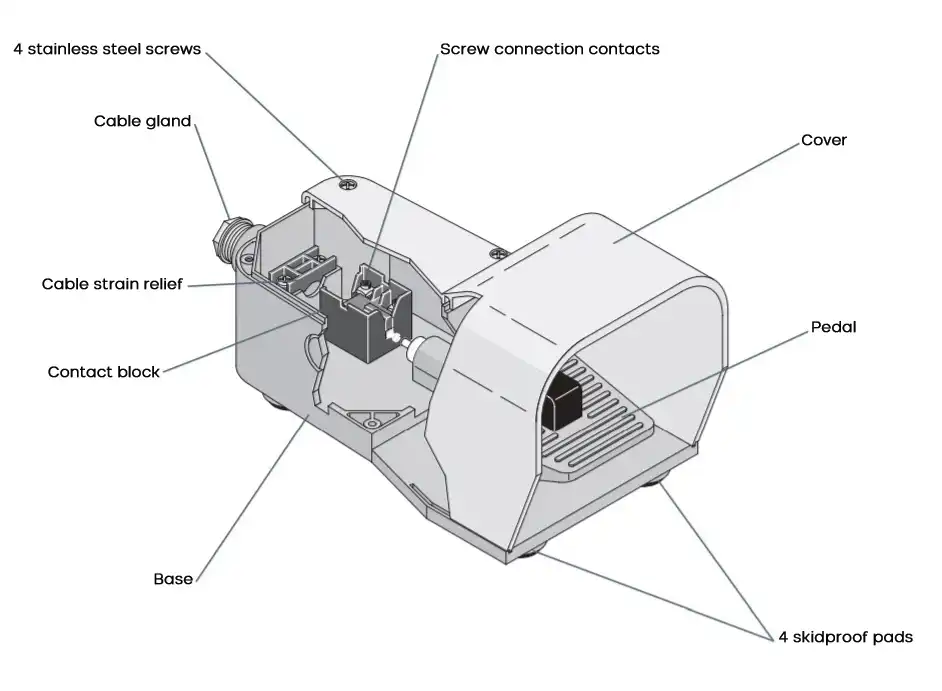
- Обкладинка: Забезпечує захист та обтічний дизайн
- Педаль: Ергономічний дизайн для комфортного керування
- 4 гвинти з нержавіючої сталі: Забезпечують надійну збірку та довговічність
- Гвинтові з'єднувальні контакти: Забезпечуємо надійність електричних з'єднань
- Кабельні вводи: Забезпечує розвантаження від натягу та ущільнення для кабельного вводу
- Зняття натягу кабелю: Запобігає пошкодженню внутрішньої проводки
- Контактний блок: Містить механізм перемикання
- Основа: Забезпечує стійку основу для всього пристрою
- 4 протиковзкі накладки: Забезпечують стійкість під час використання
Функціональність та особливості
Ножні вимикачі мають різноманітні характеристики та функції, які покращують їхню зручність у різних сценаріях. Нижче ми детально розглянемо деякі з основних функцій та можливостей:
A. Вмикання/вимикання
Ножні вимикачі в основному використовуються для базового вмикання/вимикання машин та обладнання. Ця функція дозволяє користувачам керувати пристроями без використання рук, що особливо корисно в ситуаціях, коли необхідно працювати без допомоги рук, зокрема під час живих виступів або в медичних установах.
B. Регулювання частоти обертання
Регулювання швидкості - це функція, яку мають багато педальних перемикачів, що дає змогу динамічно змінювати швидкість під'єднаного пристрою. Ця функція дуже корисна для швейних машин та інших подібних пристроїв, де точне регулювання швидкості може покращити якість роботи. Музиканти також можуть використовувати педалі ефектів зі змінною швидкістю, що дає змогу тонко модифікувати виконання.
C. Чутливість до тиску
Чутливість до тиску - це особливість деяких складних педальних перемикачів, яка дозволяє їм розпізнавати різні рівні тиску на педаль. Завдяки цій функції користувачі можуть регулювати такі фактори, як швидкість, інтенсивність або гучність у відповідь на силу натискання на педаль. Ця функція особливо популярна в музичних програмах, де незначні зміни можуть мати великий вплив на якість виконання.
D. Водонепроникні та пилонепроникні варіанти
Багато ножних вимикачів мають пило- та водонепроникне виконання (наприклад, клас захисту IP) для використання в суворих умовах. Завдяки цим характеристикам вимикачі можна використовувати на вулиці, в промислових умовах або в медичних установах, де чистота має важливе значення. Вони також гарантують, що вимикачі продовжуватимуть функціонувати навіть у складних умовах. Вибір вимикача з належним рівнем захисту навколишнього середовища збереже його функціональність і збільшить термін його служби.
E. Функції безпеки (наприклад, механізми проти спрацьовування)
Безпека є головним пріоритетом при виборі ножних вимикачів, особливо для промислового або медичного застосування. Для підвищення експлуатаційної безпеки в сучасні вимикачі включені основні елементи, що підвищують безпеку. До них відносяться міцна конструкція, що витримує інтенсивне використання і ненавмисні удари, функції аварійної зупинки для миттєвого припинення роботи в критичних ситуаціях, а також системи захисту від спрацьовування, що запобігають ненавмисній активації. У складних умовах ці заходи безпеки мінімізують небезпеку і гарантують надійну роботу.
Як підключити ножний вимикач і двигун
Джерело: https://www.youtube.com/watch?v=j3GkB9QzHy4
Спосіб підключення:
- Джерело живлення:
- Основне джерело живлення підключається до вимикачів зліва (синій двополюсний і помаранчевий триполюсний).
- Від автоматичних вимикачів живлення подається на вхідні клеми контактора (КМ1).
- Контактор (KM1):
- Контактор служить основним комутаційним пристроєм для двигуна.
- Його вхідні клеми (вгорі) підключаються до вимикачів.
- Його вихідні клеми (знизу) підключаються до трифазного двигуна.
- Підключення двигуна:
- Трифазний двигун підключається до вихідних клем контактора.
- Кожна фаза (U, V, W) підключається до відповідної клеми на контакторі.
- Контрольна схема:
- Котушка контактора підключена до ланцюга керування.
- Ножний перемикач підключений до цього ланцюга управління.
- Він підключається до допоміжних контактів NC (нормально замкнений) і NO (нормально розімкнений) контактора.
- Ножний перемикач:
- Цей перемикач використовується для запуску та зупинки двигуна.
- При натисканні вона завершує ланцюг керування, подаючи напругу на котушку контактора.
Операція:
- Коли натискається ножний вимикач, він подає живлення на котушку контактора.
- Це замикає головні контакти контактора, дозволяючи електроживлення надходити до двигуна.
- Відпускання педалі знеструмлює котушку, розмикає контакти і зупиняє двигун.
Галузі та застосування
Педальні вимикачі - це універсальні пристрої, що використовуються в різних галузях:
- Промислове обладнання: Контролюйте обладнання, керуйте процесами та підвищуйте безпеку на виробництві.
- Охорона здоров'я: Керуйте медичними пристроями без допомоги рук, покращуючи концентрацію під час процедур.
- Автомобільна промисловість: Спрощення операцій на складальних лініях та управління діагностичними інструментами.
- Музика: Дозволяє музикантам керувати ефектами та звуками під час виступів.
- Офісне обладнання: Покращуйте ергономіку, дозволяючи керувати комп'ютерами та пристроями без допомоги рук.
Переваги використання ножних перемикачів
Ножні вимикачі мають кілька ключових переваг у різних сферах застосування:
- Робота у режимі "вільні руки": Забезпечує багатозадачність і підвищує ефективність робочого процесу, особливо в медичних і промислових умовах.
- Підвищення продуктивності: Оптимізує процеси та дозволяє одночасно керувати завданнями, що дуже важливо у швидкозмінному середовищі.
- Підвищена безпека: Дозволяє керувати з безпечної відстані, зменшуючи ризики в небезпечних умовах. Такі функції, як увімкнення, забезпечують усвідомлену роботу.
- Покращена ергономіка: Зменшує навантаження на кисті та руки, знижуючи втому оператора під час виконання повторюваних завдань.
- Точний контроль: Забезпечує точну модуляцію параметрів, необхідну в додатках, що вимагають тонких налаштувань, таких як музика і медичні процедури.
Вибір правого перемикача ножної педалі
При виборі педального вимикача необхідно враховувати кілька факторів, щоб переконатися, що він відповідає конкретним потребам вашого застосування. Ось основні з них:
A. Міркування щодо різних середовищ
Педальні вимикачі використовуються в різних середовищах, від чистих медичних установ до складних промислових об'єктів. Ключові фактори включають в себе
- Показники захисту навколишнього середовища: Для зовнішнього або вологого середовища обирайте вимикачі з відповідним ступенем захисту IP (наприклад, IP54 для захисту від пилу та води).
- Температурна стійкість: Переконайтеся, що вимикач може працювати в діапазоні температур вашого середовища, наприклад, від -25°C до +70°C для деяких моделей.
- Довговічність матеріалу: Обирайте матеріали, які можуть витримати специфічні умови вашого робочого простору, наприклад, литий алюміній для важких умов експлуатації.
B. Фактори міцності та довговічності
Довговічність педального вимикача має вирішальне значення для мінімізації витрат на заміну та простоїв. Подумайте:
- Механічний та електричний термін служби: Шукайте вимикачі з високим механічним терміном служби (наприклад, ≥100 мільйонів циклів) та електричним номіналом (≥100 000 циклів), щоб забезпечити довговічність.
- Якість будівництва: Міцні матеріали та надійна конструкція підвищують довговічність. Наприклад, моделі із захисними кожухами можуть витримувати удари від падіння предметів.
C. Сумісність з існуючими системами
Переконайтеся, що педальний перемикач сумісний з вашим обладнанням:
- Типи з'єднань: Перевірте тип необхідних роз'ємів (наприклад, TS-роз'єм, гвинтові з'єднання) і переконайтеся, що вони відповідають вашим пристроям.
- Конфігурація ланцюга: Визначте, чи може вимикач задовольнити вимоги до підключення вашої системи (наприклад, нормально розімкнуті або нормально замкнуті конфігурації), щоб забезпечити належну функціональність.
D. Параметри налаштування
Багато виробників пропонують функції кастомізації, які дозволяють пристосувати педальні перемикачі до ваших конкретних потреб:
- Типи дій перемикача: Виберіть миттєву або фіксуючу дію залежно від того, як ви плануєте використовувати перемикач.
- Кількість педалей: Залежно від застосування, вам можуть знадобитися одно- або багатопедальні конфігурації для керування кількома функціями одночасно.
- Функції безпеки: Розгляньте такі опції, як механізми захисту від спрацьовування або функції аварійної зупинки, які підвищують безпеку під час роботи.
Встановлення та обслуговування
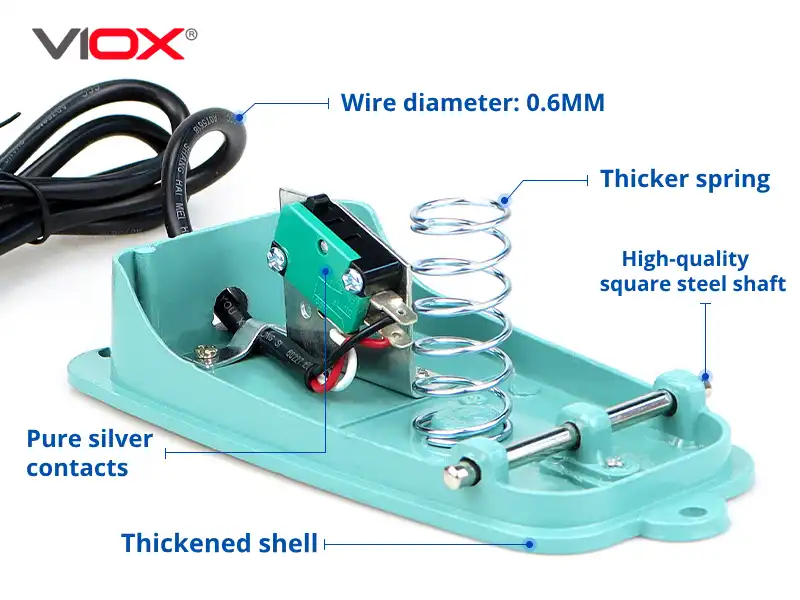
Інсталяція:
- Надайте пріоритет безпеці, відключивши живлення перед установкою.
- Дотримуйтесь інструкцій виробника для конкретних моделей.
- Забезпечте правильне підключення та заземлення.
- Перевірте функціональність перед регулярним використанням.
Обслуговування:
- Регулярно чистіть вологою ганчіркою з м'яким миючим засобом.
- Періодично перевіряйте на наявність зносу, пошкоджень і ослаблених з'єднань.
- Виконуйте планові перевірки функціональності.
Усунення несправностей:
- Якщо перемикачі не реагують, перевірте живлення та з'єднання.
- Усуньте перебої в роботі, очистивши та перевіривши компоненти.
- Запобігайте несподіваній активації, усуваючи перешкоди.
Висновок
Ножні вимикачі виявилися надзвичайно корисними інструментами в різних галузях, забезпечуючи підвищену безпеку, ефективність і контроль у широкому діапазоні застосувань. Від промислового обладнання до лікарень, ці пристрої продовжують відігравати важливу роль у спрощенні операцій та підвищенні рівня обслуговування користувачів. Різноманітність типів, функцій і можливостей ножних вимикачів дозволяє створювати індивідуальні рішення для задоволення конкретних промислових потреб. З розвитком технологій слід очікувати на подальший розвиток дизайну ножних вимикачів, можливо, з додаванням більш складних функцій. Ножні вимикачі є незамінною частиною набору інструментів будь-якого професіонала, оскільки вони мають потенціал для значного підвищення продуктивності, безпеки та операційної ефективності.
Виробники ножних вимикачів та їхні веб-сайти
- Компанія SSC Controls
- Спеціалізується на ножних вимикачах, ножних педалях і ножних контролерах TIG.
- Веб-сайт: ssccontrols.com
- VIOX
- Відомі своїми високоякісними педалями для різних застосувань, включаючи музичне обладнання та промислове устаткування.
- Веб-сайт: viox.com
- Steute Controltec
- Пропонує широкий асортимент ножних вимикачів, включаючи бездротові та вибухозахищені варіанти для різних галузей промисловості.
- Веб-сайт: steute-controltec.com
- Bernstein AG
- Надає широкий вибір промислових ножних вимикачів, розроблених для довговічності та безпеки.
- Веб-сайт: bernstein.eu
- Altech Corp
- Розробляє та виготовляє індивідуальні ножні вимикачі для промислового та медичного застосування.
- Веб-сайт: altechcorp.com
- AUSMA
- Фокусується на ефективних і довговічних педальних перемикачах, придатних для керування кількома інструментами.
- Веб-сайт: unounomall.co.za

